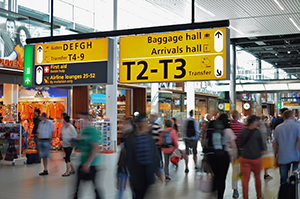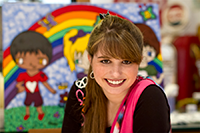
When people with disabilities go on a vacation, we don’t pack our disabilities in our luggage or leave them at home. They are part of us wherever we go. Disability is simply part of who we are, regardless of where we are.
A few months ago I was traveling by myself for the first time and had to go through an airport. Friends and family offered advice before my trip: “It isn’t that hard. Have your identification and boarding pass ready. Go through security, find your gate and wait to board the plane.”
That may sound straightforward, but it can be a lot more complicated for a person with a disability. They may need to think through many more details to feel comfortable in new surroundings or to prepare for disruptions.
The directions I got to navigate the airport, for example, did not prepare me for its bright lights, the noise or how busy and crowded it would be with people rushing to get somewhere else, bumping into each other, speaking over one another, and rifling through their suitcases at rapid speed to take out packed liquids. I didn’t know what would happen if an officer selected me for additional screening – a process that could be somewhat invasive, and I had no idea how fast or slow the line would move.
As a person with autism, I do best when I have a routine and know what to expect. Sometimes when I don’t, my mind fills with questions. Some of these questions are disability-related and another person may not have the answers. During the security check, I found myself thinking: What if they think I look suspicious because of my disability? What if my stuff gets stolen after it goes through the scanner? What if the officer selects me for screening, but she doesn’t understand it could be hard if she touches me because my disability might make me tense or sensitive to a stranger touching me? What if they change the gate at the last minute and I have to head in the completely opposite direction, and I miss my flight?
It’s a lot to take in. Not to mention that, sometimes, following too many steps can get confusing and overwhelming. A person with autism could lose focus on what the next functioning step is in the originally simple order.
Thankfully, my airport experience went smoothly; by the return trip home, I was a seasoned pro traveler.
However, the bombardment of sensory stimuli or nervousness about the unpredictable isn’t unique to me. After speaking with some of my friends with autism, we all agree that when it comes to travel, the break in the routine increases the possibility of meltdowns and sensory overload in unfamiliar, crowded places like airports.
It’s not just about getting to our destinations – it can also seem overwhelming going on that anticipated trip to the beach… and then it starts raining. Most people aren’t prepared for this, and for someone with mobility issues or autism, the rain could create even more issues.
Vacations by their very nature are disruptions in routine, but for those of us on the autism spectrum, vacation can cause confusion or fear of the unknown.
Be understanding, patient and accommodating when traveling with someone who has a disability. Remember, traveling with a disability requires additional planning and being incredibly thorough. Sometimes the best things you can do is talk things through before they happen and help make “what-if” plans, so that if things don’t go smoothly, it doesn’t cause anxiety or inaccessibility issues. Additional preparation and planning could be as easy as making sure to get an accessible hotel room, or preparing your traveling companion for the sensory experiences associated with the new place and the journey there.
While you travel with your family, my best recommendations are to be organized, plan ahead of time, and try to be empathetic.
With proper preparation and patience your travels will be that much more fun for everyone!

Haley Moss is an attorney, author, artist, speaker, and autism advocate. She is a renowned visual pop artist and the author of “Middle School: The Stuff Nobody Tells You About” and “A Freshman Survival Guide for College Students with Autism Spectrum Disorders: The Stuff Nobody Tells You About”. Her writing and artwork have been featured through media outlets such as The Huffington Post and CNN. She also serves on the boards and gives her time to numerous nonprofit organizations benefitting individuals with disabilities. To learn more about Haley, you can visit her website or follow her on social media.
Learn more about how to make life accessible for everyone
Read Ben Trockman's review of Washington D.C.'s accessibility




Connect with us on social media